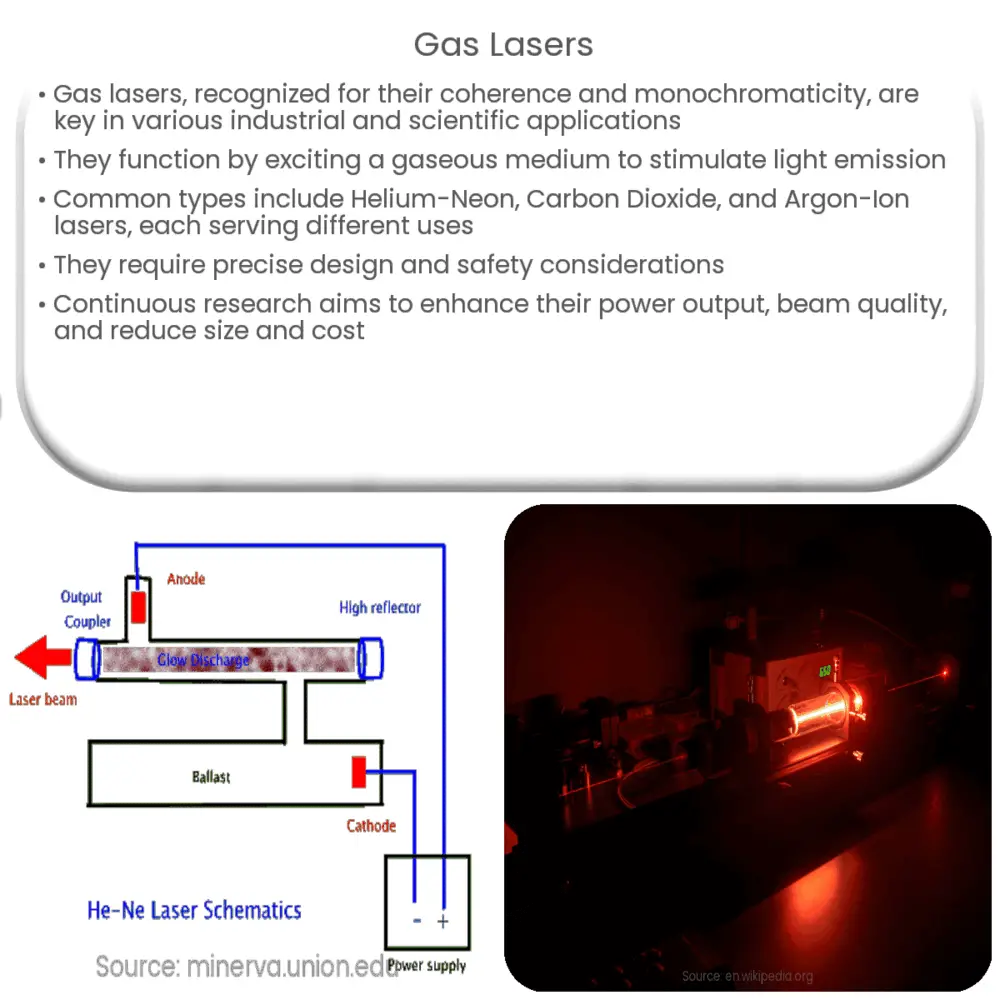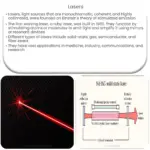Explore the world of gas lasers: their working principle, types, design, operation, safety, advancements, and future applications.

Introduction to Gas Lasers
Gas lasers, known for their coherence and monochromaticity, represent a significant category of lasers. Characterized by a gaseous gain medium, they have played a central role in various technological, industrial, and scientific applications since their development in the 1960s. The fundamental principle behind a gas laser’s operation is the amplification of light by stimulated emission of radiation, the quintessential definition of a laser.
Working Principle of Gas Lasers
At the heart of any gas laser lies its active lasing medium – the gas. This medium is typically composed of a mixture of several gases, with the specific composition dependent on the laser type. To achieve the lasing effect, the gas must be excited into a higher energy state, typically through electrical discharge. Once excited, the atoms can release energy in the form of light via the process known as stimulated emission.
The laser cavity, another fundamental component of a gas laser, contains the gas medium. This cavity is bounded by two mirrors, one fully reflective and one partially reflective, forming a Fabry-Pérot resonator. The stimulated emission triggers a chain reaction, causing other atoms in the excited state to emit light. This light then bounces back and forth between the mirrors, amplifying with each pass until it is intense enough to exit the cavity through the partially reflective mirror, forming a laser beam.
Types of Gas Lasers
- Helium-Neon Lasers: Perhaps the most well-known gas laser, the Helium-Neon (HeNe) laser, generates a bright red light. Used in various applications, including spectroscopy and barcode scanners, it’s known for its low cost and excellent beam quality.
- Carbon Dioxide Lasers: CO2 lasers are high-power continuous wave lasers. They are utilized in many industrial applications, including cutting, welding, and marking applications.
- Argon-Ion Lasers: These lasers generate light in the ultraviolet to infrared spectrum, making them useful in scientific research, medical applications, and holography.
Gas lasers are versatile tools in a plethora of domains due to their stability, precision, and the ability to operate at various wavelengths. However, their design, operation, and safety considerations are essential factors that require in-depth exploration.
Design and Operation of Gas Lasers
The design of a gas laser revolves around a gas-filled tube placed within the laser cavity. The tube contains a pair of electrodes connected to a power supply, which generates the required electrical discharge to excite the gas. While the specific construction details vary, common elements include a gas reservoir, a means for circulation of the gas, and a cooling system to manage heat generated during operation.
Successful operation of a gas laser involves maintaining the gas at an optimal temperature and pressure, as well as managing the electrical discharge for uniform gas excitation. A well-designed laser system ensures a steady, stable laser beam, and extends the lifetime of the laser.
Safety Considerations
Like all lasers, gas lasers necessitate safety precautions due to the risk of eye and skin injuries from direct or scattered light, electrical hazards, and chemical hazards from the gases used. Safety eyewear is often required, as well as insulated enclosures for high-voltage components. Safe handling and storage of gases, particularly in high-powered lasers, is crucial.
Advancements and Future Applications
Gas lasers continue to evolve with advancements in technology. Recent research focuses on enhancing the power output, improving the beam quality, and reducing the size and cost. Emerging applications include environmental monitoring, telecommunications, and advanced manufacturing, offering promise for the future.
Conclusion
In conclusion, gas lasers, with their diverse types and applications, continue to be a cornerstone of laser technology. From the common helium-neon lasers to the high-powered carbon dioxide lasers, they have made a substantial impact across multiple sectors. Despite their established utility, continuous advancements ensure that they remain at the forefront of scientific and technological progress. As we delve deeper into the realm of light and its interactions, gas lasers undoubtedly will continue to illuminate our path.



